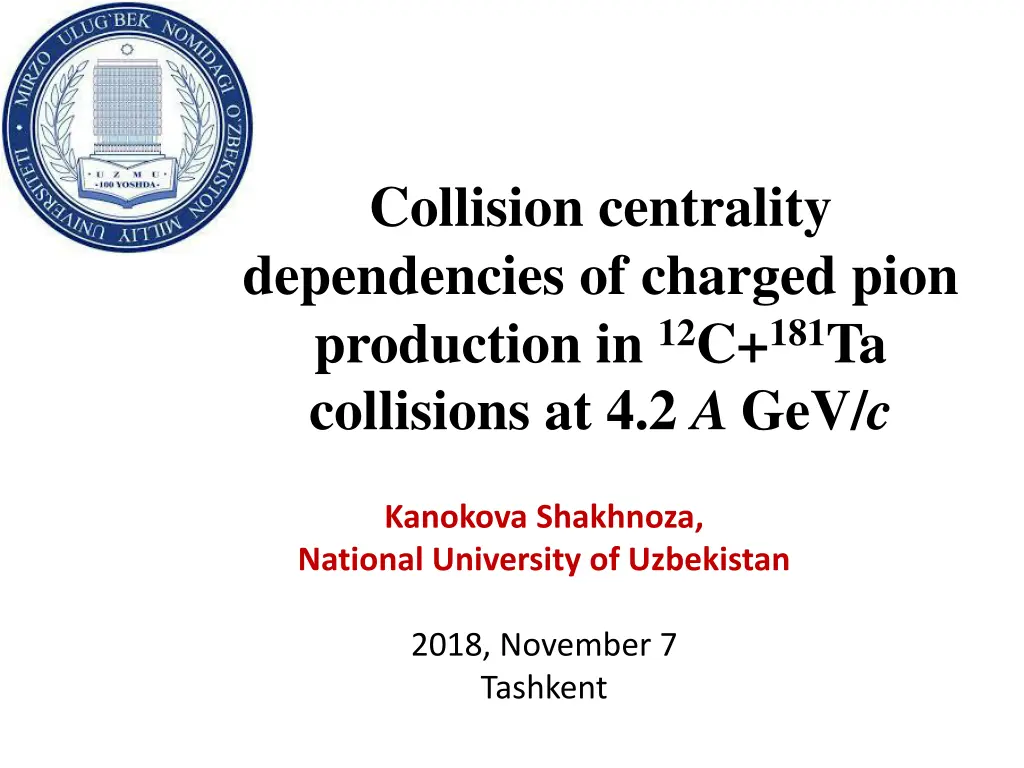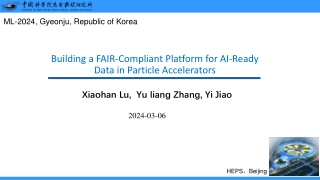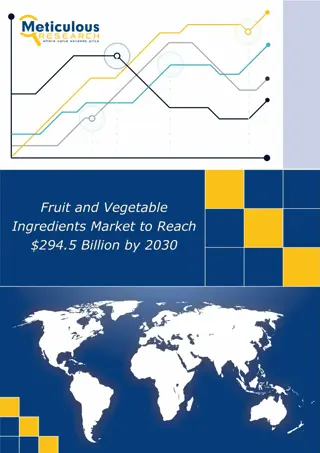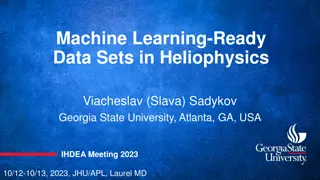
Charged Pion Production in Nuclear Collisions
Explore the dependencies of charged pion production in 12C+181Ta collisions at 4.2 A GeV/c, focusing on collision centrality and incident energy. Investigate the characteristics and distributions of pions to extract valuable information on high-energy hadron-nucleus and nucleus-nucleus collisions. Statistical data and results analysis provided.
Download Presentation

Please find below an Image/Link to download the presentation.
The content on the website is provided AS IS for your information and personal use only. It may not be sold, licensed, or shared on other websites without obtaining consent from the author. If you encounter any issues during the download, it is possible that the publisher has removed the file from their server.
You are allowed to download the files provided on this website for personal or commercial use, subject to the condition that they are used lawfully. All files are the property of their respective owners.
The content on the website is provided AS IS for your information and personal use only. It may not be sold, licensed, or shared on other websites without obtaining consent from the author.
E N D
Presentation Transcript
Collision centrality dependencies of charged pion production in 12C+181Ta collisions at 4.2 A GeV/c Kanokova Shakhnoza, National University of Uzbekistan 2018, November 7 Tashkent
The relevance of research Most part of collision energy in relativistic nuclear collisions is spent on pion production. Therefore, investigation of the collision centrality and incident energy dependencies of the rapidity and transverse momentum distributions of pions is of importance to extract the valuable information on the dynamics of the hadron-nucleus and nucleus-nucleus collisions at high energies
The relevance of research The present work is devoted to investigation of the dependencies of the characteristics of the charged pions on the collision centrality in nucleon. average kinematical 12C+181Ta collisions at 4.2 GeV/c per
Selection of events by 12C+181Ta collision centrality centrality Selection of events by collision N n Peripheral collision .prot . p part N 2 n Central collisions . . p part prot Semicentral collision n where participant protons. is the mean multiplicity per event of .prot . part N the number of participant protons collision centrality was used to define the p
Table 1. The fraction of events (), the average number of participant protons (< >), the mean multiplicity per event of the charged pions (<n( )>), the ratio R( )=<n( )>/< >, the average total energy (< iEi( )>) (in MeV) of the charged pions per collision event at various centralities in12C+181Ta collisions at 4.2 GeV/c per nucleon. Statistical errors are shown. Collision Centrality Quantity Peripheral Semicentral Central 59 1 24 1 17 1 , % < > 5.0 0.1 19.6 0.2 33.5 0.3 1.49 0.04 5.31 0.09 7.98 0.13 <n( )> 1.25 0.03 4.90 0.10 7.66 0.15 <n( +)> 0.30 0.04 0.27 0.03 0.24 0.05 R( ) 0.25 0.02 0.25 0.06 0.23 0.08 R( +) 671 24 1 817 74 2 138 56 < iEi( )> (in MeV) 490 12 1 870 33 2 845 44 < iEi( +)> (in MeV)
We can estimate the expected ratio <n()>/<n(+)> in 12C+181Ta collision system, using the simple model, which assumes that the number of the produced positive and negative pions is proportional to the number of colliding (involved) protons and neutrons, respectively, and that, for simplicity, each involved nucleon of a projectile nucleus undergoes just a single collision with a nucleon of a target nucleus. The probability of a single neutron-neutron (neutron from projectile12C6with neutron from target181Ta73) collision is W(nn) 0.3 and that of a single proton-proton (proton from projectile W(pp) 0.2. Similarly, one can calculate the probabilities of a single proton-neutron and neutron-proton collisions equal to W(pn) 0.3 and W(np) 0.2, respectively. 12C with proton from target 181Ta) collision is
The probability of a single nucleon-nucleon W(NN) collision is equal to 1 (W(NN)=W(nn)+W(pp)+W(pn)+W(np)=1). Using the above probabilities, one can estimate the ratio <n( )>/<n( +)> in12C+181Ta collision system as follows: The ratio <n( )>/<n( +)> proved to be 1.20 0.05, 1.08 0.04, and 1.04 0.03 in the peripheral, semicentral, and central 12C+181Ta collision events, respectively, decreasing noticeably with increasing the collision centrality.
Table 2. The average values and widths of the spectra of the full (P), transverse (Pt) and longitudinal (Pl) momenta (in MeV/c) and emission angles ( ) (in degrees) of the charged pions in the laboratory frame at various centralities in 12C+181Ta collisions at 4.2 GeV/c per nucleon. Statistical errors are shown. Collision Centrality Semicentral Quantity Peripheral Central + + + 550 11 489 15 440 11 493 12 223 4 176 5 43.1 0.8 35.6 0.7 476 11 459 16 343 11 472 17 240 5 192 5 51.5 0.8 35.2 0.6 443 7 395 10 325 7 417 10 218 3 164 4 51.1 0.6 36.2 0.5 474 8 420 11 315 8 423 12 272 4 218 6 55.4 0.7 35.2 0.5 362 6 326 10 220 6 345 10 210 3 162 4 60.2 0.7 38.4 0.4 462 7 399 9 276 7 391 10 290 4 242 6 60.4 0.7 36.0 0.6 < > DP < l> DPl < t> DPt < > D
Fig1.The momentum distributions of the negative (a) and positive (b) pions in peripheral (open circles) and central (closed circles) laboratory frame. The distributions are normalized per one pion. Statistical errors are shown. 12C+181Ta collisions at 4.2 GeV/c per nucleon in the b) a) 0 0 10 10 * p), (GeV/c)-1 +* p), (GeV/c)-1 -1 10 -1 10 -2 10 N/(N -2 N/(N 10 -3 10 -3 10 0.0 0.5 1.0 1.5 2.0 2.5 3.0 3.5 4.0 0.5 1.0 1.5 2.0 2.5 3.0 P, GeV/c P, GeV/c
Fig. 2. The emission angle distributions of the negative (a) and positive (b) pions in peripheral (open circles) and central (closed circles)12C+181Ta collisions at 4.2 GeV/c per nucleon in the laboratory frame. The distributions are normalized per one pion. Statistical errors are shown.
Summary and Conclusions The collision centrality dependencies of the average experimental kinematical characteristics of the negative and positive pions, produced in 12C+181Ta collisions at 4.2 A GeV/c, were investigated. We observed the significant increase of the mean multiplicities per event of both or +mesons with increasing the12C+181Ta collision centrality. The mean multiplicity of the negative pions proved to be noticeably larger as compared to that of the positive pions in the analyzed three centrality groups of12C+181Ta collisions. Using the simple model, we estimated the ratio <n( )>/<n( +)> to be 1.22 in12C+181Ta collision system.
Summary and Conclusions (2) The suppression of the ratio <n( )>/<n( +)> in the semicentral and central12C+181Ta collision events as compared to the calculated model ratio <n( )>/<n( +)> 1.22 was observed. The ratio <n( )>/<n( +)> proved to be 1.20 0.05, 1.08 0.04, and 1.04 0.03 in the peripheral, semicentral, and central decreasing noticeably with increasing the collision centrality. 12C+181Ta collision events, respectively, We observed the clear differences between the emission angle distributions of the charged pions produced in the peripheral and central 12C+181Ta collisions at 4.2 GeV/c per nucleon. The peripheral collisions were characterized by the distinct peaks for both or + mesons at the relatively small values of emission angle ( 20-300) in the laboratory frame.
Summary and Conclusions (3) The fraction of the charged pions with the large momenta in the normalized full momentum distributions of the negative and positive pions decreased significantly with an increase in centrality of12C+181Ta collisions at 4.2 A GeV/c. The fraction of the charged pions with small emission angles decreased and that with the large emission angles increased significantly for both the negative and positive pions with increasing the12C+181Ta collision centrality. The average values of the full momentum distributions and their widths for the charged pions decreased significantly with an increase in 12C+181Ta collision centrality.
Summary and Conclusions (4) The above observations confirm our finding that the number of the relatively slow charged pions produced in secondary interactions (rescatterings) on nucleons of target181Ta nuclei increases significantly with increasing the collision centrality, which results in an increase of the average emission angle of + and mesons. The results of the present work can be useful for analysis of the centrality dependence of the charged pion production in heavy ion collisions at high energies.






















